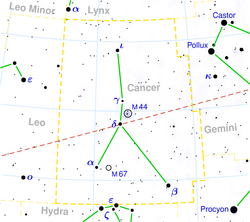Delta Cancri
| Observation data Epoch J2000.0 Equinox J2000.0 |
|
|---|---|
| Constellation | Cancer |
| Right ascension | 08h 44m 41.1s |
| Declination | +18° 09′ 15″ |
| Apparent magnitude (V) | +3.94 |
| Characteristics | |
| Spectral type | K0III |
| U−B color index | 0,99 |
| B−V color index | 1,08 |
| Variable type | unknown |
| Astrometry | |
| Radial velocity (Rv) | +17.14 km/s |
| Proper motion (μ) |
RA: -17.67 mas/yr Dec.: -229.26 mas/yr |
| Parallax (π) | 24.98 ± 0.24mas |
| Distance | 131 ± 1 ly (40.0 ± 0.4 pc) |
| Absolute magnitude (MV) | 0.824 |
| Other designations | |
| Database references | |
| SIMBAD | data |
Delta Cancri (δ Cancri, abbreviated Delta Cnc, δ Cnc), also named Asellus Australis, is an orange giant star approximately 180 light-years from the Sun in the constellation of Cancer.
Since it is near the ecliptic, it can be occulted by the Moon and very rarely by planets.
δ Cancri (Latinised to Delta Cancri) is the star's Bayer designation.
It bore the traditional name Asellus Australis which is Latin for "southern donkey colt". In 2016, the International Astronomical Union organized a Working Group on Star Names (WGSN) to catalogue and standardize proper names for stars. The WGSN approved the name Asellus Australis for this star on 6 November 2016 and it is now so entered in the IAU Catalog of Star Names.
It also has the longest of all known traditional star names, Arkushanangarushashutu, named such by the ancient Babylonians and which means "the southeast star in the Crab".
In Chinese, 鬼宿 (Guǐ Su), meaning Ghost, refers to an asterism consisting of Delta Cancri, Theta Cancri, Eta Cancri and Gamma Cancri. Consequently, Delta Cancri itself is known as 鬼宿四 (Guǐ Su sì, English: the Fourth Star of Ghost.)
...
Wikipedia

